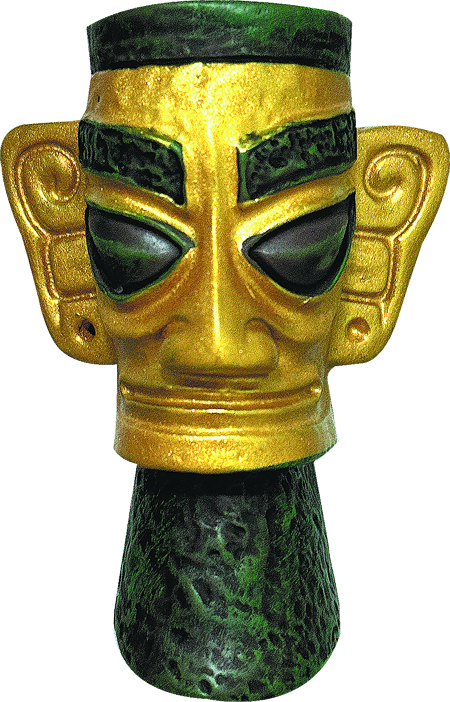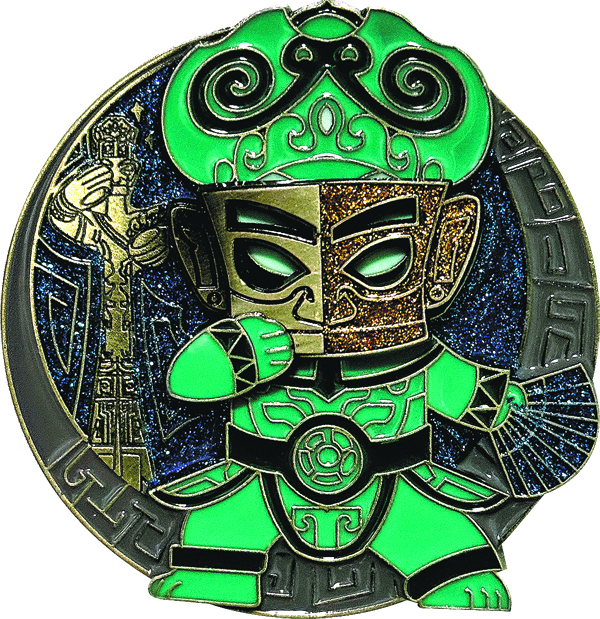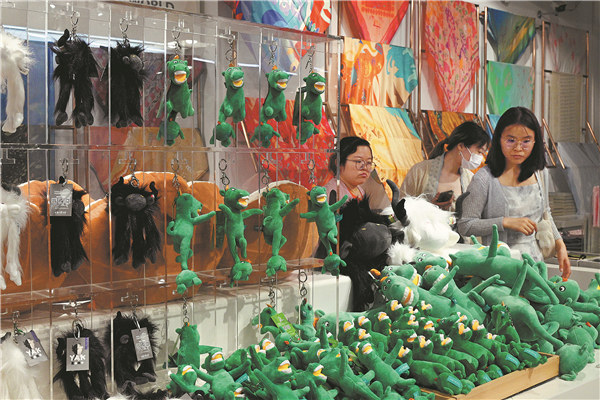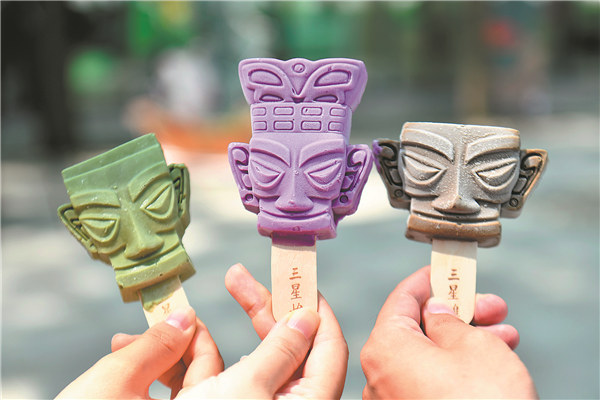Young people swell demand for creative cultural items
From:China DailyAuthor: 2024-09-25 10:08

Fridge magnets in the shape of a bronze mask on display at Sanxingdui Museum in Guanghan, Sichuan province.[Photo by Du Lianyi/China Daily]
Museums produce rare, beautiful, fun goods based on relics, art, history
When art designer Lu Xue decided to transform the inspiration she took from the renowned Tang Dynasty (618-907) painting Court Ladies Adorning Their Hair with Flowers into tangible art curios, they struck a major chord with museum patrons.
Her creations include butterfly-shaped rings, and bracelets and earrings featuring preserved flowers and natural stones of different hues. Since the items hit the market at the beginning of the year, visitors to the Liaoning Provincial Museum in Shenyang have been lining up to buy the items.
During the summer vacation, some of the items from the series, such as a Chinese-style corsage, were among the top sellers at the museum in the provincial capital.
"When I laid my eyes on the precious ancient painting at the museum, I noticed that women in ancient times wore cut flowers as part of their attire. This inspired me to think about how we could apply fresh flowers to modern girls, allowing them to wear flowers in a different way," said Lu, who used to be a floral artist.
The classic work by renowned artist Zhou Fang paints a vivid picture of the life of palace women who wore their hair styled into high, cloud-like buns, with fluffy "sideburns". Between the buns are inserted flowers including Chinese peonies, lotuses, and hydrangeas.
The painting is a microcosm of the Tang Dynasty, full of elegance and grandeur, and showcasing an epoch of wealth and splendor, said Dong Baohou, vice-curator of the Liaoning museum.
Lu carefully selected natural pink, blue and green stones and sealed dried flowers in them by using modern technology, giving the flowers an amber texture and a colored glaze.
"This cultural and creative product not only brings cultural relics to life, but also allows more people to learn about China's excellent traditional culture," said Lu who is part of the cultural and creative team assembled by the museum last year.
To date, the team has developed hundreds of items — ranging from bookmarks, costumes, cosmetics and skincare products — which bear elements of cultural pieces at the museum. Last year, sales of those products reached 14 million yuan ($1.96 million), the museum said.

Fridge magnets in the shape of a warrior on display at Sanxingdui Museum in Guanghan, Sichuan province.[Photo by Du Lianyi/China Daily]
New wave emerges
Cultural licensing and cross-industry collaboration have been thriving in recent years, taking the cultural and creative industries into a new era, Dong said.
This new wave of cultural and creative products not only meets fashion demands but also highlights the significance of culture, and aligns well with the consumption preferences of the younger generation, Dong added.
Elsewhere in the city, the Shenyang Palace Museum — where the imperial complex of three emperors of the Qing Dynasty (1644-1911) was located — has launched ice creams, cakes and refrigerator magnets featuring historical architecture or cultural items. The goods have been in great demand.
At the Shenyang Museum, visitors have snapped up mugs bearing dragon motifs, scarves with floral patterns of Liao Dynasty (916-1125) vases, and refrigerator magnets shaped like the museum's dome.
Cultural and creative items sold by museums across the province raked in 69.68 million yuan in the first six months of this year, up 206.5 percent over the same period last year, local government data showed.
"Nowadays, many people are willing to visit museums, especially parents who are eager to take their children to museums to enrich their knowledge and broaden their horizons," said An Yiwen, who runs cultural tours in Shenyang.
"They also hope to bring home some unique items from the museums. From this perspective, there is still a lot of market potential for cultural and creative products," An said.
Museum bookings made via Meituan for the first two weeks of July — the start of the summer vacation — were 15 times the amount for the same period in June, the e-commerce platform said. Over the same comparison period, the number of users on the review app Dazhong Dianping discussing museums more than doubled.
China is home to more than 6,800 registered museums, which attract 1.29 billion visits a year, according to the National Cultural Heritage Administration.

Visitors browse for souvenirs at the art and life gallery in the Gansu Provincial Museum in Lanzhou, Gansu province in May last year.[Photo by Qu Juan/For China Daily]
By popular demand
Some cultural and creative products, however, have proved more popular with cultural travelers.
In 2023, the National Library of China in Beijing launched a pillow shaped like its collection of Yongle Dadian, the world's first encyclopedia, which was completed in 1408 after being commissioned in 1403 by Emperor Yongle of the Ming Dynasty (1368-1644).
Since then, the pillow has recorded brisk sales, with some buyers even posting comments saying it had helped cure their insomnia.
In 2019, the national library launched over 1,500 cultural and creative products themed around ancient books, which have brought in over 60 million yuan in total revenue.
The Beijing Municipal Cultural Heritage Bureau said several museums under its jurisdiction, including the Capital Museum and the Grand Canal Museum of Beijing, have established cultural and creative spaces.
The revenue from cultural and creative products sold in museums across Beijing exceeded 200 million yuan in 2023, according to local authorities.
The recent 2024 Cultural and Creative Industry Report released by the Shanghai-based Mob research institute showed that 95.5 percent of consumers surveyed are willing to purchase such products.
The two main reasons consumers buy cultural and creative products are to display them in collections or for daily use, the report said. Buyers pay close attention to the design, price and variety of these products, it added.
E-commerce platforms have surpassed traditional brick-and-mortar stores to become the main way the products are purchased.
Video platforms like Bilibili, Douyin, and Kuaishou are popular sources for consumers to obtain information about the products, and genuine customer reviews help buyers make quicker purchasing decisions, the report said.
The ongoing Civilization of Ancient Egypt exhibition at the Shanghai Museum, for instance, has created a buying spree. At the museum's flagship store on Alibaba's Tmall, Egyptian cat keychains, tote bags bearing the exhibition logos, and mummy pendants are in high demand.
Many of these products have experienced supply shortages since the exhibition started on July 19. The online store offers more than 200 cultural products related to the exhibition and some have had to be restocked on a daily basis since August, according to store staff.
The Gansu Provincial Museum struck gold in July when it rolled out fluffy toys in the shape of broccoli, mushrooms, crab sticks, meatballs, and rice cakes to celebrate malatang, a spicy hot pot considered a local specialty.
In the first week of August, the museum said its Tmall store saw a 343 percent year-on-year increase in product sales.

Ice creams replicating bronze masks at the Sanxingdui Museum in Guanghan, Sichuan province, are displayed.[Photo by Yi Fang/For China Daily]
Young buyers
Young consumers born in the 1990s and 2000s are becoming a driving force behind the consumption of museum-themed cultural and creative products, data from the online travel platform Mafengwo showed.
They have grown up with the internet and desire items that are "individual" and provide them with a special experience or knowledge. This demand has driven the continuous upgrade of such products, the platform said.
As a result, cultural and creative products have evolved from simple items like postcards and badges depicting museums. They now include creatively designed relic refrigerator magnets, and archaeology blind boxes, which have an element of surprise and mystery for buyers.
These cultural and creative products are now a main attraction for young people visiting museums, according to the Mafengwo report.
The fusion of museum culture and creativity not only promotes a diverse range of products, but also shows the immense market potential for related industries, experts said.
The market size of China's cultural and creative products reached $16.38 billion in 2023, an increase of 13.09 percent year-on-year, according to an industry report by the Beijing-based consultancy, the Intelligence Research Group.
There are currently about 35,300 cultural and creative-related companies in the country, data from business registrations tracker Qichacha showed. In 2023, there were 336 new registrations, representing a year-on-year growth of nearly 10 percent.
A relatively complete industry chain for cultural and creative products has already taken shape in China, the Mob research report said. This chain is extensive, covering various related industries from creative design to product manufacturing, sales, and consumption, it pointed out.
In 2021, Chinese authorities rolled out a set of measures to encourage the development of creative cultural products inspired by museums, libraries, memorial halls, and other cultural sites.
Such products should help people better understand and boost confidence in Chinese culture, according to a document jointly issued by eight departments including the Ministry of Culture and Tourism, the National Development and Reform Commission, and the National Cultural Heritage Administration.

Customers view the cultural creative products at the souvenir shop of the Henan Provincial Museum in Zhengzhou, Henan province.[Photo provided to China Daily]
Incentives rolled out
Preferential tax and income incentives have also been offered to boost the production and promotion of these products.
Cultural heritage organizations have been encouraged by authorities to invest in and establish creative product companies. Private investors have also been motivated to take part in developing creative products.
In July, the Ministry of Human Resources and Social Security officially recognized cultural and creative product planning and operations specialists as new professions. This recognition will be an important factor in driving the development of the cultural industry, experts said.
Liu Ziqi, co-founder of the cultural and creative product brand DuckSong in Xi'an, Shaanxi province, said such products have greater cultural and sentimental value for consumers. "They're what players in the industry should focus on," Liu said.
In June, DuckSong came up with fluffy cute "mittens" that allow visitors to understand the process of making roujiamo, a crispy, oven-baked bun filled with diced pork that is a Shaanxi specialty.
After one of the buns is made, it is handed to the customer inside the mitten, which immediately becomes a popular item with customers. To date, more than 10,000 orders have been placed for the mitten.
Liu attributes the success of the product to the combination of cultural charm, traditional cuisine, and it also having elements of fun and fashion.
He is confident similar creative products will emerge in the future. "It will be all the more promising. As consumer preferences evolve and are upgraded, the demand for high-quality cultural and creative products will continue to grow," he said.
Wu Liyun, a professor at the China Academy of Culture and Tourism at Beijing International Studies University, said the popularity of such products is based on the public's growing interest in traditional culture.
Many products with innovative designs and unique shapes align with young people's tastes. They can also serve as a bridge for the public to learn about the culture of a specific historical period, and thus expand cultural influence.
Wu said the development of such products should focus on unique cultural elements, and added that homogenization of these products should be avoided.

A soft toy cultural product of Gansu Provincial Museum in Lanzhou. It is inspired by the museum's iconic bronze sculpture, "Galloping Horse Treading on a Flying Swallow".[Photo provided to China Daily]
Edit:孙俪洋
The copyright of the article and the picture belongs to the original author. If there is any infringement, please contact to delete it